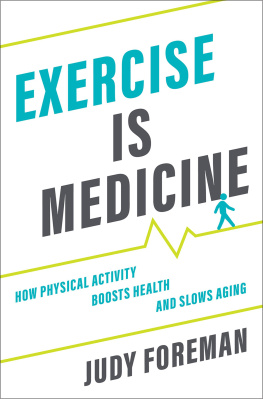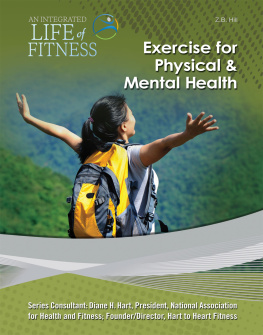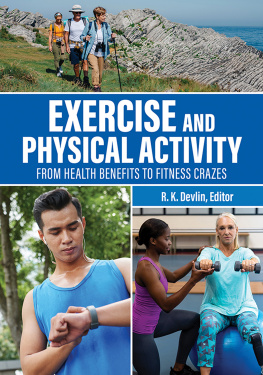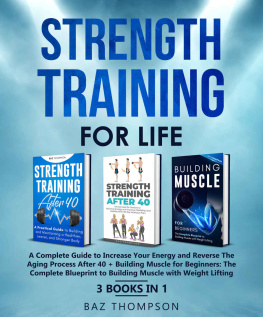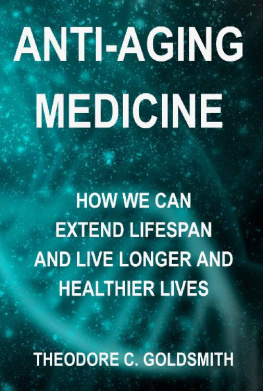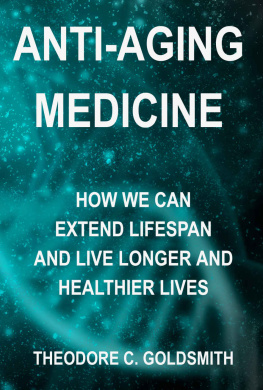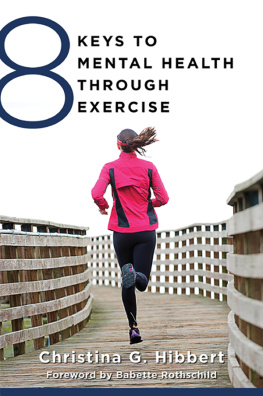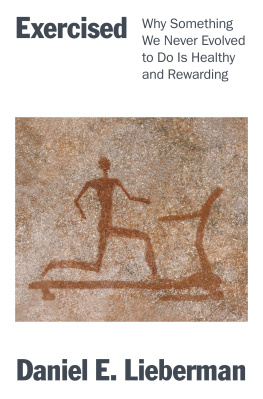Exercise Is Medicine

Oxford University Press is a department of the University of Oxford. It furthers the Universitys objective of excellence in research, scholarship, and education by publishing worldwide. Oxford is a registered trade mark of Oxford University Press in the UK and certain other countries.
Published in the United States of America by Oxford University Press
198 Madison Avenue, New York, NY 10016, United States of America.
Judy Foreman 2020
All rights reserved. No part of this publication may be reproduced, stored in a retrieval system, or transmitted, in any form or by any means, without the prior permission in writing of Oxford University Press, or as expressly permitted by law, by license, or under terms agreed with the appropriate reproduction rights organization. Inquiries concerning reproduction outside the scope of the above should be sent to the Rights Department, Oxford University Press, at the address above.
You must not circulate this work in any other form and you must impose this same condition on any acquirer.
Library of Congress Cataloging-in-Publication Data
Names: Foreman, Judy, author.
Title: Exercise is medicine : how physical activity boosts health and slows aging / Judy Foreman.
Description: New York, NY : Oxford University Press, [2020] |
Includes bibliographical references.
Identifiers: LCCN 2019009496 | ISBN 9780190685461 (hardback) |
ISBN 9780190685478 (updf) | ISBN 9780190685485 (epub)
Subjects: LCSH: Exercise therapy. | ExerciseHealth aspects.
Classification: LCC RM725 .F66 2019 | DDC 615.8/2dc23
LC record available at https://lccn.loc.gov/2019009496
To Mike, Robin, Owen, and Hugo, my dear ones. And to Ken, my beloved husband, with much, much love and many thanks.
The EXERCISE IS MEDICINE trade mark is used with the agreement of the American College of Sports Medicine. The content of this work was developed independently by the author and publisher and is not affiliated with, endorsed, or in any other way sponsored by the American College of Sports Medicine and its EXERCISE IS MEDICINE initiative, which seeks to make physical activity assessment and promotion a standard in clinical care, connecting health care with evidence-based physical activity resources for people everywhere of all abilities. For more information visit www.exerciseismedicine.org.
Contents
Thanks first and foremost, to my terrific editor at Oxford University Press, Abby Gross.
Thanks also to Florence Graves, Founding Director of the recently closed Schuster Institute for Investigative Journalism at Brandeis University, not only for welcoming me as a Senior Fellow, but also for supporting this book over the years with a steady supply of fantastic research assistants. They include Yuchen He, Kimberly Milando, and most especially, Stephanie Yan. Many, many thanks to all. Thanks, also, to Lisa Button, managing editor at the Schuster Institute, for finding the perfect assistants for my project from the pool of outstanding Brandeis students. Thanks, too, to my agent, Jim Levine.
In addition, a number of scientists have gone way beyond the call of duty in responding repeatedly to my phone calls and emails to help me understand the thorniest scientific questions. They include Steve Austad, Steve Blair, Claude Bouchard, Carl Cotman, Monika Fleshner, Matt Kaeberlein, I-Min Lee, Benjamin Levine, Barbara McGovern, Martin Gibala, Steve Horvath, Jay Olshansky, Stuart Phillips, David Slovik, Bruce Spiegelman, Mark Tarnopolsky, and Henriette van Praag. Thank you, thank you, thank you.
I am also very grateful to the following scientists and physicians who helped me with specific chapters.
Chapter 1:
Steve Austad
S. Jay Olshansky
Michael Rose
Daniel Lieberman
Matt Kaeberlein
Steve Horvath
Lorenzo Galluzzi
Gary Ruvkun
Chapter 2:
Claude Bouchard
Steve Blair
Trina Hosmer
Jerome Fleg
Jeffrey Metter
Eleanor Simonsick
I-Min Lee
Claudia Kawas
Chapter 3:
Peter T. Katzmarzyk
I-Min Lee
Ken Kaplan
Benjamin Levine
C. Ronald Kahn
Chapter 4:
Katherine Beiers
T. K. Skenderian
I-Min Lee
Benjamin Levine
Arthur Leon
Jonathan Myers
Jay Handy
Timothy Church
Chapter 5:
Mark Tarnopolsky
Christopher Gillen
Martin Gibala
Mark Mattson
Marcia Haigis
Darrell Neufer
Paul McLean
Bruce Spiegelman
David Hood
Chapter 6:
Mark Tarnopolsky
Stuart Phillips
Orly Lacham-Kaplan
Chapter 7:
Lynda Bonewald
Clifford Rosen
Mark Hamrick
David Slovik
Chapter 8:
Carl Cotman
Henrietta van Praag
Mercedes Parades
Shawn Sorrells
Chapter 9:
Carl Cotman
Michael Otto
Ronald Duman
Rod Dishman
Elizabeth Droge-Young
Chapter 10:
Paul Cotter
Lita Proctor
Barbara McGovern
Heather Buschman
Chapter 11:
Monika Fleshner
Connie Rogers
Brandt Pence
Chapter 12:
Marcia Bailey
Karen Mustian
Bradley J. Behnke
Jennifer Ligibel
Chapter 13:
Mary Armanios
Masood Shammas
Steve Horvath
Matt Kaeberlein
Eli Puterman
Elissa Epel
Carol Greider
Jay Olshansky
Chapter 14:
Matt Kaeberlein
Steve Austad
Lorenzo Galluzzi
Todd Manini
C. Ronald Kahn
Irene Mazzoni
David Sinclair
Bruce Spiegelman
Chapter 15:
Benjamin Levine
Frank Hu
Claude Bouchard
I-Min Lee
Mark Tarnopolsky
Bruce Spiegelman
David Becker
Chapter 16:
Thomas Perls
Elizabeth Arias
Aging, to most of us, especially on a bad day, is an appalling prospect, and, all too often, a grim reality. It represents a diminution of much that we have been, a penultimate phase of life, a slow, downward slide into decrepitude, disability, and dependence, a one-way street toward an all-too-literal dead end. As a friend of mine put it, its knowing youre on your next-to-last dog.
To a biologist, though, aging is one of the most exciting mysteries in the universe, a tale told in the chemical language of every cell and repeated in the life span of every organism. What is aging, anyway? Why arent humans like salmon, who die immediately after laying and fertilizing their eggs? Why arent we like mayflies, whose lives consist only of birth, reproduction, and a spectacularly fast death? For that matter, why arent we like some clams, which can live for hundreds of years? Or like 40-year-old bats?
Why does aging even exist, and why is there senescence, this gradual loss of function and vigor? Why do we live so long after our reproductive years are over?
Its possible that we live a long time after reproduction because in social species like oursas with elephants, wolves, and monkeysits advantageous to have postmenopausal females around to act as reservoirs of knowledge about watering holes, food supplies, and child rearing. But while this grandmother effect might explain long life, it doesnt explain senescencewhich makes you wonder, is senescence necessary? Is it part of the evolutionary deal? Are we stuck with it?
Or could things be different? Could we have what scientists call compression of morbidity, that is, long, healthy lives

